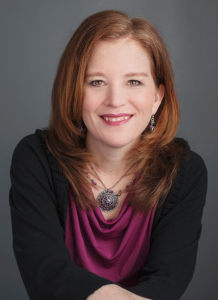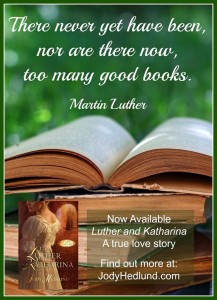Jody Hedlund ~ Author Interview
Welcome back to Rachel’s Back Talk! Another Friday interview!
While you may have remembered me interviewing Jody Hedlund before, this week, I am celebrating the release of her newest book Luther & Katharina.
So without further ado, on to Rachel’s Back Talk – Special Edition!
Interview:
RR: Welcome back to Rachel’s Back Talk, Jody! Your latest book, Luther and Katharina, details the true romance between Katharina von Bora and Martin Luther. What led you to this remarkable story?
JH: As I homeschooled my children and gave them history lessons, I began learning a lot about some of the great heroes of the faith. I was particularly fascinated by the wives of these great heroes, especially those who were long forgotten by our modern world, women who had stood by their husband’s sides during dangerous times and had helped shape those men into the heroes they became. I wanted to bring these women to life for our modern generation. I wanted to tell their stories.
Katharina von Bora is one of those women who has been largely ignored by today’s culture, but she’s a strong woman whose story deserves to be told every much as her husband’s. I’m excited about sharing her story, about her daring and dangerous escape from a convent, how she met Luther, and how the two of them overcame many obstacles to eventually fall in love and form a strong marriage.
RR: What a wonderful idea! It’s obvious that research plays an enormous role in the development of your scenes and the characters that inhabit them. How did you begin the arduous task of researching these two historical figures and the period in which they lived?
JH: One of the first things I do in the early research phase of any of my stories based on real historical figures is I locate as many biographies on the couples and individuals as I can get my hands on. Usually I can get quite a number through my library system. Once I figure out the books that will be the most helpful to me, I usually buy them.
After I have the biographies I spend an enormous amount of time reading through them, taking pages and pages of notes, and trying to gain a realistic grasp of the people and the events that fall within the time frame that I hope to write about (which usually entails the romance relationship–how the couple met, fell in love, and ended up together).
Once I’ve scoured the biographies, I begin the next phase of my research which is to delve into the details regarding the time period and setting. Usually I try to focus on gaining a “feel” for the era. I try to understand the social and political climate. I familiarize myself with wars or other disruptions happening during the time. And then I round out my research by studying clothes, food, homes, life styles, etc.
The process is intense and takes me weeks before I’m finally ready to begin the actual writing process.
RR: That does sound intense, but it is so worth it in the long run. As you began to read and learn more about Katharina, what particularly captivated you about her?
JH: I was particularly fascinated by the fact that Katharina had once been a nun. And as we know, nuns take a vow of celibacy.
I was curious to know why she’d become a nun in the first place. What led her to that decision? And then what made her later decide to forsake her vows? What was life like for her after escaping her convent knowing that if she was caught and recaptured, she could face persecution and even death for running away? What were her hopes and dreams for her life after she’d denied herself for so long? What was it like for her to interact with men when she’d never before had the opportunity?
All of those questions and more reverberated through my mind. And what I really wanted to know was how she’d ended up with Martin Luther. What brought this couple together? It was a forbidden love during a time of incredible turmoil. It was a love that was never-meant-to-happen. So how did it come about?
RR: Could you tell us a little about the cloistered life that Katharina would have grown up in? What was it like to be a nun?
JH: During the middle ages, many men and women entered cloistered life. Everywhere throughout Europe, abbeys and monasteries were built and the church at the time encouraged cloistered life. For men, becoming a monk was a way to gain a good education, to learn to read and write when there weren’t many options to do so. Monastic life provided protection from the many dangers of the middle ages. And it also was a way to become more spiritual during a time when salvation was thought to be something one could earn or buy.
Women usually didn’t enter cloistered life voluntarily, at least during the time of Martin Luther during the late 1400’s and early 1500’s. Instead, noblemen often looked at a convent as a place to put their unwanted daughters. Many noblemen, particularly land-rich but monetarily poor knights, couldn’t afford a large dowry for their daughters which was required to make a favorable and advantageous match within the nobility. Of course, it was out of the question for those noble daughters to “marry down” in class, to laborers or tradesmen who wouldn’t require so hefty a dowry. So rather than try to come up with the appropriate funds to make a noble match, many noblemen decided to put their daughters into convents.
Similar to men who entered monasteries, cloistered life for women was seen as advantageous. So fathers didn’t feel too guilty about putting their unwanted younger daughters into a sheltered life of service to God because the convent was a place where they would be safe, fed, clothed, housed, and usually taught to write and read. Although a severe lifestyle, it was relatively easy and comfortable and suited to a woman of noble birth.
RR: To close today, could you tell us what you hope your books bring to your audience beyond the entertainment factor? What do you want a reader to walk away with after having read Luther and Katharina?
JH: First I hope that after witnessing the great commitment of faith of believers in past ages, readers will come away with a greater commitment to their own personal faith especially in light of the difficulties and trials that may come our way. If a man like Martin Luther was willing to go to the stake for what he believed, that should give us courage. And if a woman like Katharina von Bora risked her life, comfort, and future for her growing faith, that too should inspire us to do the same.
Second, I hope that readers will have a greater appreciation and understanding of the dangers and difficulties that many went through in their efforts to preserve the gospel of Jesus and to correct corruption. Again, I ask readers to consider what they’re willing to face in order to stand against corruption and to speak the truth in today’s culture that is once again shifting away from Scripture.
RR: Thank you so much for joining us here, Jody, and talking about your newest book!
If you missed my review for Luther & Katharina, read it here!
 Jody Hedlund is a best-selling and award-winning author who loves history and happily-ever-afters. She makes her home in Midland, MI with her husband and five children. When she’s not writing another of her page-turning stories, you can usually find her sipping coffee, eating chocolate, and reading.
Jody Hedlund is a best-selling and award-winning author who loves history and happily-ever-afters. She makes her home in Midland, MI with her husband and five children. When she’s not writing another of her page-turning stories, you can usually find her sipping coffee, eating chocolate, and reading.
Contact Jody:
I hang out on Facebook here: Author Jody Hedlund
I also love to chat on Twitter: @JodyHedlund
My home base is at my website: jodyhedlund.com
For lots of fun pictures, follow me on Pinterest: pinterest.com/jodyhedlund
I get personal on Instagram: instagram.com/JodyHedlund/
Or you’re welcome to email me at: jodyhedlund@jodyhedlund.com



 Follow
Follow





 I am a 22-year-old, history-lover, coffee-fanatic, author, and book reviewer.
I am a 22-year-old, history-lover, coffee-fanatic, author, and book reviewer.